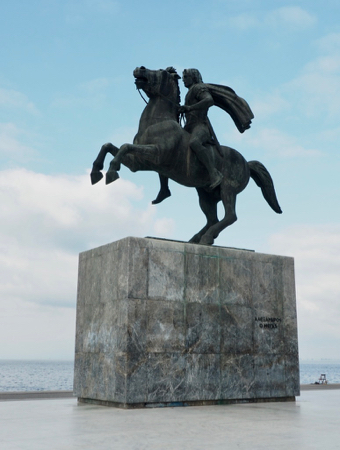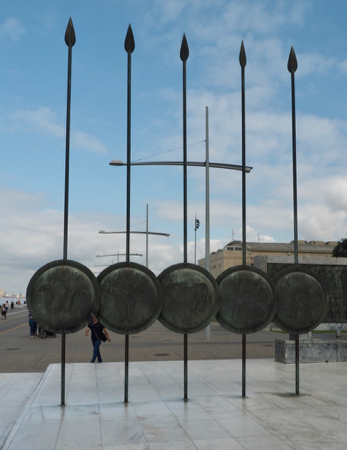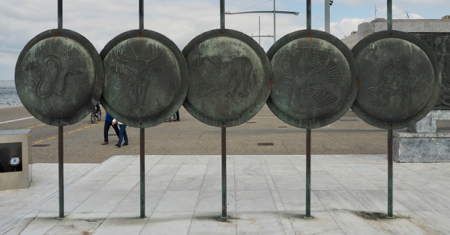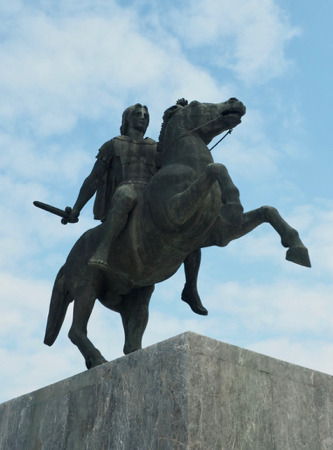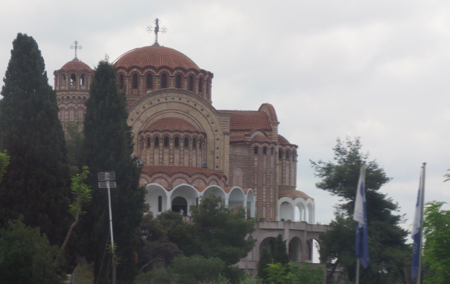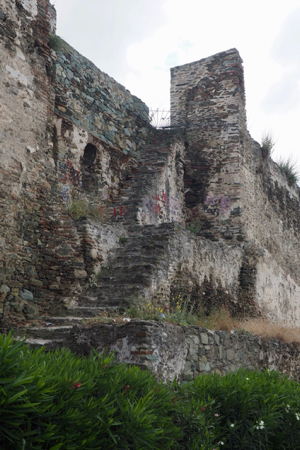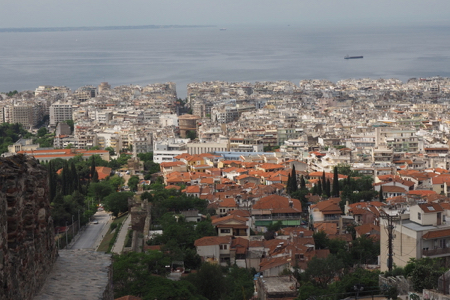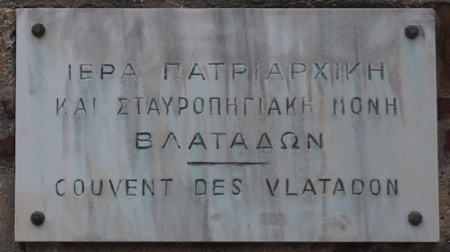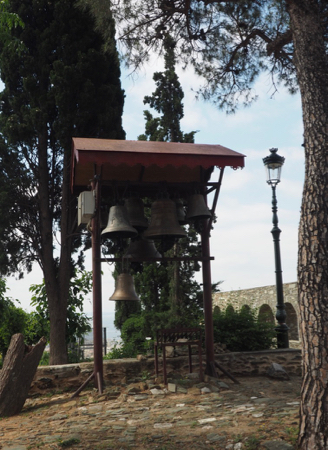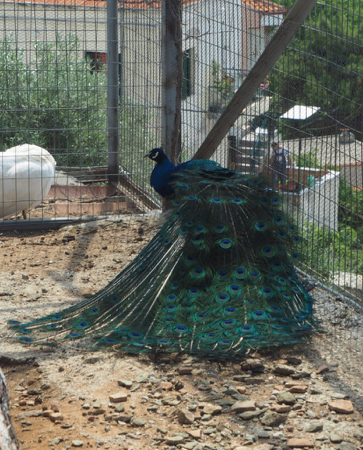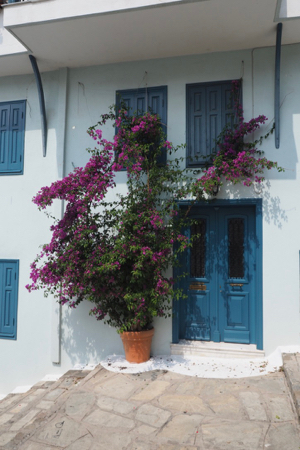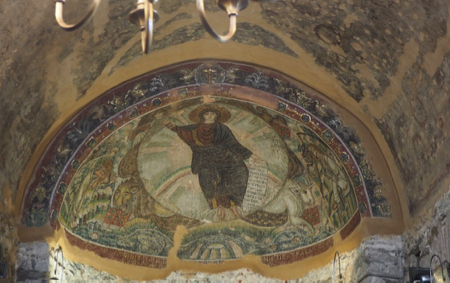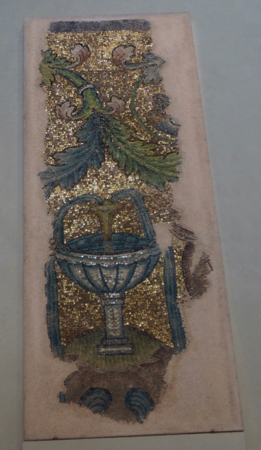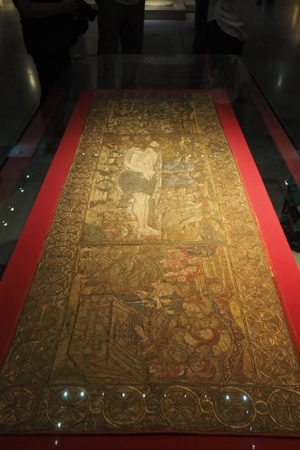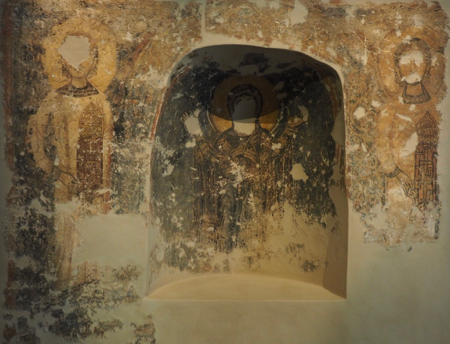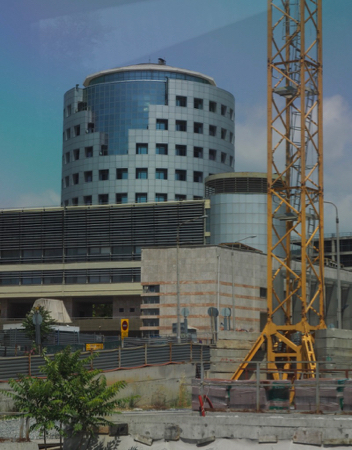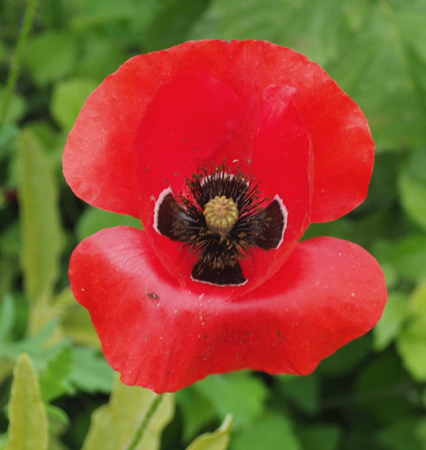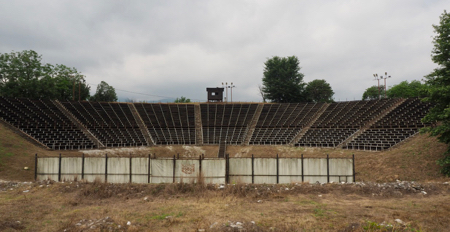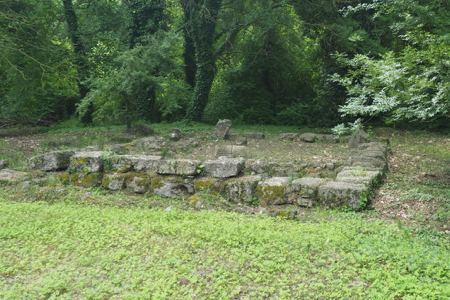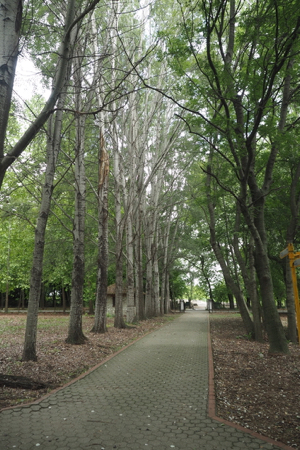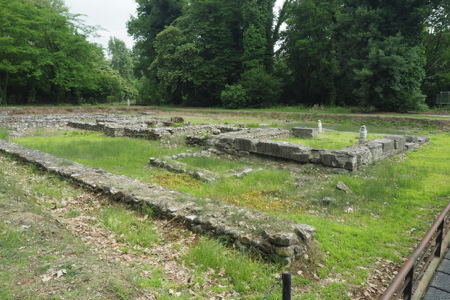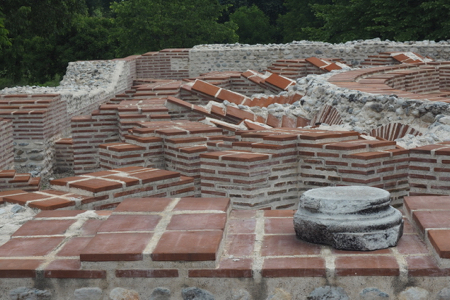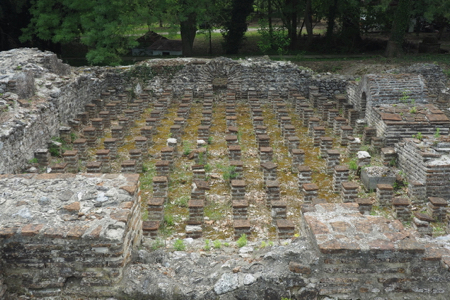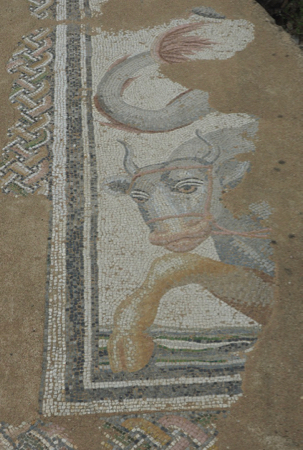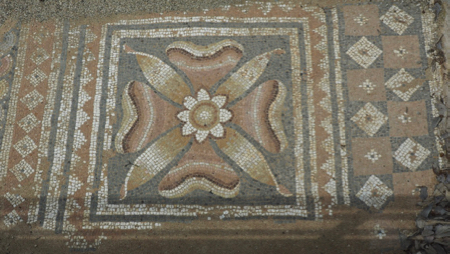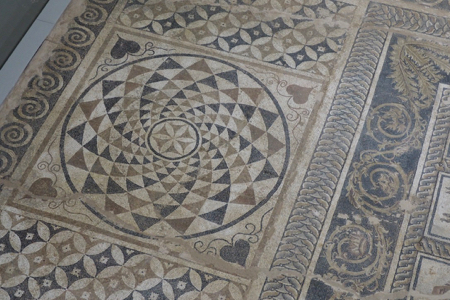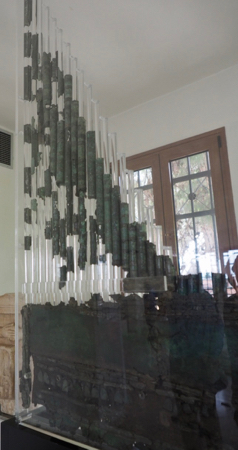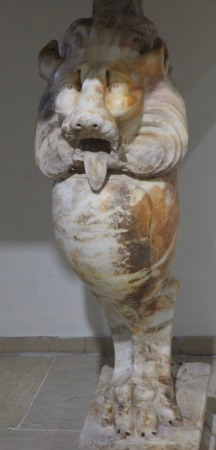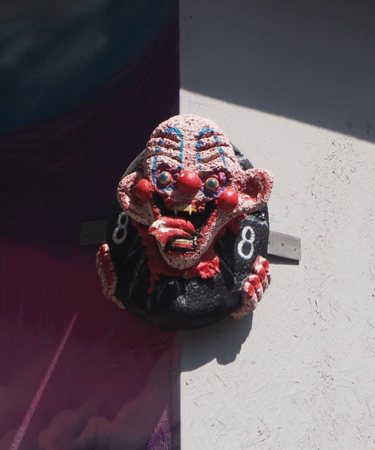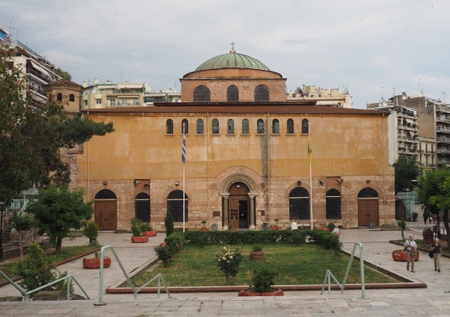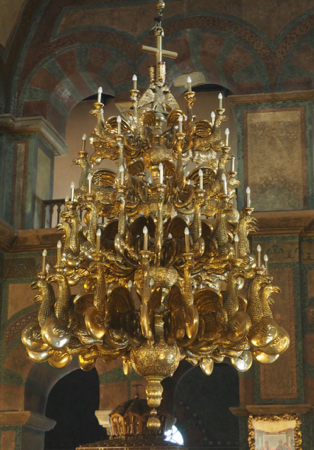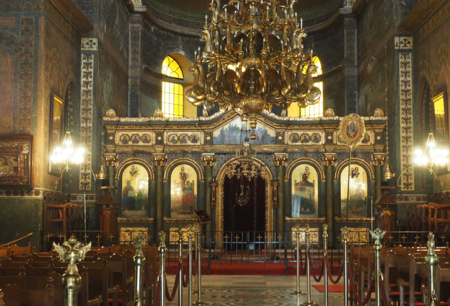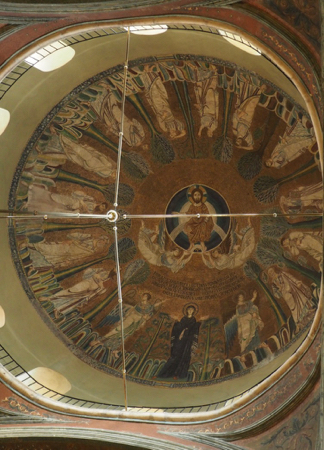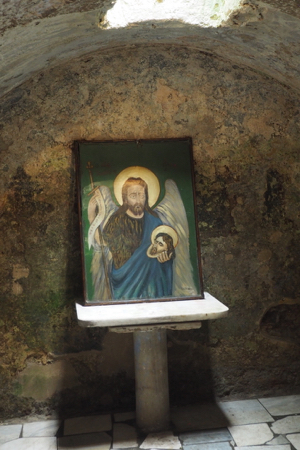Sat., 5/12/18 - Fly to Thessaloniki
We were up at 5 AM for our 7:45 flight to Thessaloniki - bags out at 5:45, “breakfast” at 6 AM, and departure from the hotel at 6:30.
After an uneventful flight, we were able to check in to the hotel before 9 AM and then went for a walking orientation with Alexandra. She pointed out restaurants, ATMs, a supermarket, etc. We convinced her we wanted food at 12:00 and ate at The Kitchen Bar on the pier. The staff were not very accommodating, but Marge got a Greek salad and I had a pork souvlaki. Both were good.
At 7 PM, Marge and I went out to the little cafes along the alleys and picked one for dinner. We had more souvlaki with fries, baked eggplant with feta and dried tomatoes and yummy fried zucchini with tzatziki.
Sun., 5/13/18 - Thessaloniki
This morning started with an hour of briefing by Alexandra at 9 AM. We met the rest of our group of 15. We have a large bus while in Greece and it is nice to have two seats per person. As we drove east to the statue of Alexander the Great on his horse Bucephalus (Big Head) we passed Aristotle Square where yesterday and today 12 volleyball courts were set up on the cement. I would guess the teams of girls or boys were 12 to 14 year-olds. They served overhand, passed, and set but then kind of threw the ball over. At least it was an organized activity for youth.
Our guide today in Thessaloniki is another Marie. We heard some of Alexander’s history and the history of the naming of this city.
Statue of Alexander the Great on Bucephalus
Sarissas - long spears used by Alexander
Sarissas
On our way up to the upper town in our bus, Marie told us the history of Thessaloniki with all its earthquakes, fires, and invasions, and conquests. We stood outside the Tower of Trigonio at the north end of the old fortified wall and had a great view of the city, the sea, and the port.
Church of St. Paul
Part of the Walls of Thessaloniki
Part of the Walls of Thessaloniki
View from the Tower of Trigonio
We walked downhill on cobblestones to the Vlatadon Monastery. It was built in the mid-14th c., during the Byzantine period, and is still active today.
Bells in the courtyard
Resident peacock
Street scene
We walked further down the steep hillside to the Monastery of Latomou. Here there is a stone church from the 5th c. built on the ruins of a Roman bath. Inside is a gorgeous mosaic of the epiphany of Ezekiel with Jesus, without a beard, sitting on a rainbow. In the corners are the four books of the gospels held by a lion, an eagle, an angel, and a cow (probably a sacred bull).
Bells of the Monastery of Latomou
Our bus took us to the Museum of Byzantine Culture.
Marie took us on a tour of the museum. We started with the early Christian Churches (330 CE) built to impress pagans or Jews with the might of the church through high ceilings and lots of light, sculptures, frescos, and mosaics. We looked at mosaic floors, amphorae recycled into city water pipes, and learned of Byzantine burials.
Museum of Byzantine Culture
Fresco
Mosaic
Mosaic
Frescos
Interesting building
We rode the bus back to the Mediterranean Palace and walked up the street to find a pastry to eat with coffee in our room.
At 5:30 we met in the hotel for a discussion on Greece’s financial problems. Dimitri Kostinos, an economics professor from the Univ. of Macedonia here in Thessaloniki, spoke for almost two hours - so I won’t be including his explanation in my journal. The gist is that due to stupid financial planning, Greece was deeply in debt. The EU gave them three bailouts (110, 140, and 80 billions of Euros) to pay their creditors, but now they owe the IMF over 175 billion Euros to pay back the loans. The Greek austerity penalties have helped steady things and their economy is rising at 2%, but they are trying to negotiate default forgiveness on their debts. Tax evasion is still a huge problem here.
Our welcome dinner was another multi-course meal at Panellinion.
Mon., 5/14/18 - Thessaloniki and Dion
Today we drove west and then south to the Dion Archaeological Site. The route took us across the Macedonian Plain where the deltas of four rivers have deposited silt and created a very fertile area. The swamps were drained and now rice is grown there. Kiwis and melons are grown on the drier areas.We got only a faint glimpse of Mt. Olympus, the home of the 12 Greek gods, through the clouds. There was some snow among the craggy peaks. The summit is 9,570 feet and was first climbed in 1913 by a Swiss photographer.
Poppy
Mt. Olympus (Wikipedia photo - it was a cloudy day for us)
Dion is an ancient sanctuary site. Citizens came to sacrifice animals to the gods on Mt. Olympus. Animals were burned on an alter so the smoke would rise to Mt. Olympus. Later some “Olympic” contests - athletics and drama - were organized at this site. There was a running track and an Odea (theater) where Euripides staged his last two plays. In 5 CE earthquakes and flooding destroyed the site. Only 30% has been excavated and half was recovered in this year’s mudslides.
We walked a little of the Roman city with the Via Maximus separating the villas and shops from the public areas. We looked at the men’s toilets and the ruins of the baths and the small theater where men debated.
Butterfly
Odea (theater)
Dragon fly
Latrine
Baths
Hypocaust
Mosaic
Mosaic
At the Dion Museum we looked at a water pipe with a keyboard like an organ. Air was pumped into a water chamber and sent sound up the pipes. A woman’s grave had a song and notation for what sound to play above the words. It was very interesting.
Water pipe
Statue
Street scenes
Corner decoration
Wall mural
At 5:45 we joined Alexandra to walk to the Church of Agia Sophia. The Crusaders built the church in the 14th c., then it became a mosque, and in the 19th c. became a church again. The church is dedicated to Wisdom with Hope, Faith, and Love, and not to a saint.
Church of Agia Sophia
Church of Agia Sophia
Church of Agia Sophia
We walked across the street to enter the Catacombs of John the Baptist. The structure was once part of a Roman bath. Outside was the water nymph’s baptistery. Confusing!
Catacombs of John the Baptist
Catacombs of John the Baptist
We ate cheese and crackers, bread, and PB in our room and repacked.
| Return to Top | Return to Itinerary | Return to Trips page to view other trips | Return to Dreamcatcher Home Page |
